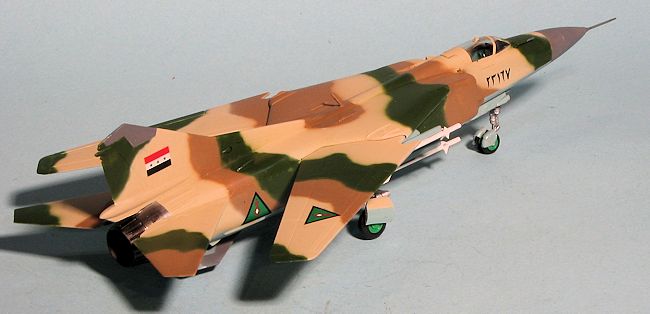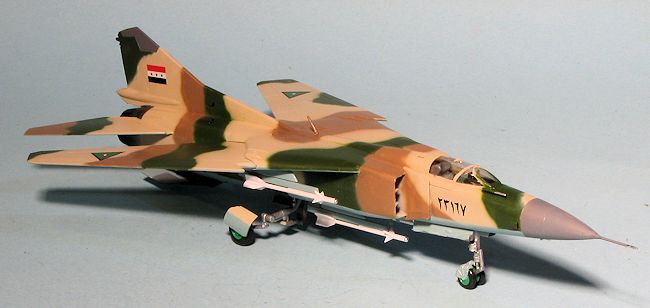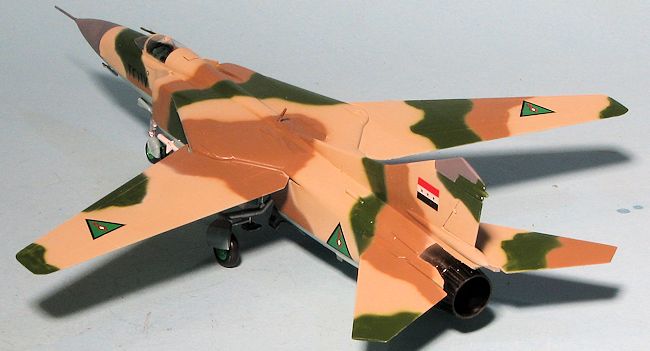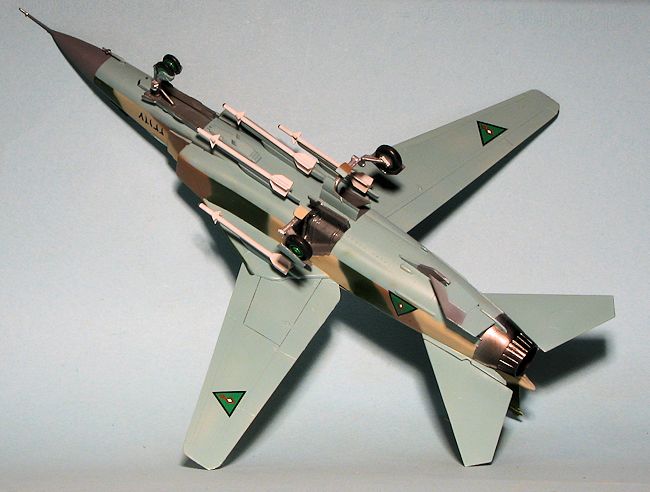
Heller 1/72 MiG-23 Flogger
| KIT #: | 80319 |
| PRICE: | $Raffle ticket item |
| DECALS: | Two options |
| REVIEWER: | Scott Van Aken |
| NOTES: |

| HISTORY |
The Mikoyan-Gurevich MiG-23 (Russian: Микоян и Гуревич МиГ-23; NATO reporting name: "Flogger") is a swing-wing fighter aircraft, designed by the Mikoyan-Gurevich bureau in the Soviet Union and is considered to belong to the "Third Generation" aircraft category along with similar aged Russian-produced fighters like the MiG-25 "Foxbat". It was the first Soviet fighter with a look-down/shoot-down radar and beyond visual range missiles, and the first MiG production fighter plane to have intakes at the sides of the fuselage. Production started in 1970 and reached large numbers with over 5,000 aircraft built. Today the MiG-23 remains in limited service with various export customers.
As the Flogger A (MiG-23S/MS) was not that widely built or sold and had several major deficiencies in equipment, it is most likely that this kit is a Flogger B. Information on those versions is listed below.
 slats. The R-29-300 (R-29A) engine was now rated for 12,500 kg. It finally had the definitive sensor suite: an improved Sapfir-23D (NATO: 'High Lark') radar, a TP-23 infra-red search and track (IRST) sensor and an ASP-23D gunsight. The 'High Lark' radar had a detection range of some 45 km against a high-flying, fighter-sized target. It was not a true Doppler radar, but instead utilized the less effective "envelope detection" technique, similar to some radars on Western fighters of the 1960s.
slats. The R-29-300 (R-29A) engine was now rated for 12,500 kg. It finally had the definitive sensor suite: an improved Sapfir-23D (NATO: 'High Lark') radar, a TP-23 infra-red search and track (IRST) sensor and an ASP-23D gunsight. The 'High Lark' radar had a detection range of some 45 km against a high-flying, fighter-sized target. It was not a true Doppler radar, but instead utilized the less effective "envelope detection" technique, similar to some radars on Western fighters of the 1960s. and two Molniya R-60 (NATO: AA-8 'Aphid') short-ranged infrared missiles. From 1974 onwards, double pylons were installed for the R-60s, enabling up to four missiles to be carried. Bombs, rockets and missiles could be carried for ground attack. Later, compatibility for the radio-guided Kh-23 (NATO: AS-7 'Kerry') ground-attack missile was added. Most Soviet MiGs were also wired to carry tactical nuclear weapons. Some 1300 MiG-23Ms were produced for the Soviet Air Force (VVS) and Soviet Air Defense Forces (PVO Strany) between 1972-78. It was the most important Soviet fighter type from the mid-to-late 1970s.
and two Molniya R-60 (NATO: AA-8 'Aphid') short-ranged infrared missiles. From 1974 onwards, double pylons were installed for the R-60s, enabling up to four missiles to be carried. Bombs, rockets and missiles could be carried for ground attack. Later, compatibility for the radio-guided Kh-23 (NATO: AS-7 'Kerry') ground-attack missile was added. Most Soviet MiGs were also wired to carry tactical nuclear weapons. Some 1300 MiG-23Ms were produced for the Soviet Air Force (VVS) and Soviet Air Defense Forces (PVO Strany) between 1972-78. It was the most important Soviet fighter type from the mid-to-late 1970s.| THE KIT |
Not what one would consider a cutting edge design in today's market. But when it first appeared in the mid/late 1970s, it was very much the norm with raised panel lines and fairly good detailing for the time. One must remember that during these heady days, it was not uncommon for a model company to provide a new-mold kit release or two every month. Of course, in today's economy that is not always possible, but things have changed; and from my perspective, most of it is for the better.
The fuselage is split into upper and lower halves as befits a model of an aircraft with variable geometry wings. A Spartan cockpit consisting of little more than floor, seat, control stick, pilot (to help fill the space) and instrument panel are supplied. This isn't a major problem as the one piece canopy is a bit thick. There is more than enough room in the nose for the required weight. The swing wings are connected by a simple bar and if one doesn't play with it too much, it should be sufficient. The tail section is an unusual construct as the upper rear fuselage is incorporated with each fin half. A connector bar is provided for the horizontal stabilizers, which need to be installed when the fin halves  are cemented together. This makes them prime targets for breaking off when one fills the inevitable seam between the upper and lower rear fuselage.
are cemented together. This makes them prime targets for breaking off when one fills the inevitable seam between the upper and lower rear fuselage.
Landing gear are fairly well done and sturdy. The main wheels have a notch in them for the mud guards while those for the nose are molded in place. Lower fin is designed to be molded in the folded position as would be the norm while on ground. For things under wings, one has a centerline fuel tank and the option of various missiles on the wing glove and under fuselage. These have some sink marks on the pylons and ejector marks on the missile bodies. A centerline gun is also provided.
Instructions are well done with Humbrol paint references. Decals are nicely printed and are matte with relatively large clear surrounds. They are for two aircraft, both of them in the multi-colored camouflage as shown on the box art. No unit information is provided, but one is for a Soviet and the other a Polish aircraft. The markings guide shows insignia on the upper wing of the Polish aircraft which may not be prototypical so some research may be needed.
| CONSTRUCTION |
I decided to do this one pretty much out of the box. First thing I did was to glue the centerline tank halves together, then the lower wing inserts into the wings and the fin/upper rear fuselage halves together. Fit on all of these are fair with filler being needed on all seams. The cockpit floor and rear bulkhead were glued in and painted Soviet Interior Blue-Green, a Model Master Enamel shade. I painted the bang seat representation a dark grey. The instrument panel was also painted Blue-Green and the instrument blanks painted black. The panel was glued into the upper fuselage half and after cementing in the control stick I attached about 4 grams of nose weight.
4 grams of nose weight.
Then the assembled wings had the little attachment section stuck in place. The wings were installed on the lower fuselage section. Before closing the upper and lower fuselage bits, I opened up a couple of holes in the lower forward nose. These are not shown needing to be opened up, but if you do not, you'll not be able to attach bits in the last steps. It is a good idea on this one to see what holes need to be so treated before starting construction. I forgot to open the centerline tank slot so had to leave that item off the completed model.
There was more than the usual amount of filler required for the seams as they all needed it. I then attached exhaust cone. Fit was fairly good on the bottom but the upper half had a bit of a step that needed to be removed. I did this by scraping as the area was too thin for sanding sticks. I then looked at the remaining sprues and noticed a couple of small intakes. The instructions show just one in the general area of the forward fin and it seems it attaches to the fin itself, but there is already one molded in place. On the decal guide it shows them more clearly and they were glued on. Part #44, which is a small blade antenna is shown floating free on the instructions with no indication of where it goes. Back to the decal guide which shows it fitting to the lower fuselage.
I then installed the kit seat and then the canopy section. This seemed like a good time to get the painting done as I knew it would take a while.
| COLORS & MARKINGS |
The decal sheet I used from RV Resin has a lot of nice markings but a poor on-line only reference that just shows side views. I did some web searches and found several schemes for MiG-23s and decided to use one shown for the Iraqi Air Force. Again, the instructions w ere not very good in terms of colors so looking through my Model Master enamel selection, I chose Sand, FS 34102 and FS 30219 for the upper shades with FS 35414 for the underside. I painted the underside colors first and then the sand followed by the green and brow. A blu-tak sort of material was used to hold the main gear doors in place while all this painting went on. It took a while and I had to do a bit more additional painting to get the areas covered over by the fuselage on the swing wings. Looking back, I would have probably been better off to mask the shades, but I free-handed them as I like painting in this manner.
ere not very good in terms of colors so looking through my Model Master enamel selection, I chose Sand, FS 34102 and FS 30219 for the upper shades with FS 35414 for the underside. I painted the underside colors first and then the sand followed by the green and brow. A blu-tak sort of material was used to hold the main gear doors in place while all this painting went on. It took a while and I had to do a bit more additional painting to get the areas covered over by the fuselage on the swing wings. Looking back, I would have probably been better off to mask the shades, but I free-handed them as I like painting in this manner.
| FINAL CONSTRUCTION |
With the colors on and dry, I returned to the bench to take care of the rest of the bits. I painted the wheel wells a darkish grey as well as the inside of the gear doors. The undercarriage legs were then assembled. The main gear legs are three pieces and rather tricky at first, but once assembled and dry, are very convincing looking. All the gear legs were painted aluminum. These were then installed and I used super glue to help them set properly as the fit is a bit loose. The wheels were then painted and installed. The main wheels have notches in them for the gear doors that fit there.
 Main gear doors are a single piece that needs to be cut into three sections. Not difficult, but it could be a bit easier. The doors were then glued in place with the very small lower gear doors being somewhat troublesome to get to stay on the small, tall peg that is provided for them.
Main gear doors are a single piece that needs to be cut into three sections. Not difficult, but it could be a bit easier. The doors were then glued in place with the very small lower gear doors being somewhat troublesome to get to stay on the small, tall peg that is provided for them.
I then installed the lower fin bits with no trauma as well as the various pitots and antennas. These were later brush painted. I also glued on the missile racks. The kit missiles are not very good, so I used the ones out of an ESCI F-100 which are a bit better, but still rather crude. The kit was then given a gloss coat in readiness for decals.
The RV Resin decals are nicely printed and went on without any fuss. I had a terrible time finding a photo of the wing markings and was only able to locate one on a model where the modeler put them on upside down. I used that as a guide. They reacted well to Microsol. I did find that the kill marking was off register but used it anyway.
With the decals dry, I did the usual touchup painting and then gave it a coat of semi matte. The missiles were attached, the tape removed from the transparency and that was it.
| CONCLUSIONS |
 I have to admit that for a kit I won at a raffle and hadn't really intended to build, it turned out fairly well. I expected a lot of filler and that is what I got. The end result is a nice looking model that will be plunked into the MiG collection and fill the MiG-23 hole. I am sure there are better kits of this aircraft out there, but for a relatively trouble-free build, this one can't be beat.
I have to admit that for a kit I won at a raffle and hadn't really intended to build, it turned out fairly well. I expected a lot of filler and that is what I got. The end result is a nice looking model that will be plunked into the MiG collection and fill the MiG-23 hole. I am sure there are better kits of this aircraft out there, but for a relatively trouble-free build, this one can't be beat.
| REFERENCES |
December 2013
Copyright ModelingMadness.com. All rights reserved. No reproduction in part or in whole without express permission from the editor.
If you would like your product reviewed fairly and fairly quickly, please contact the editor or see other details in the